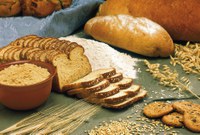Prairie Fare: What is gluten anyway?
(Click an image below to view a high-resolution image that can be downloaded)
By Julie Garden-Robinson, food and nutrition specialist
NDSU Extension
“We need to find a gluten-free restaurant,” I said to my husband.
Our daughter’s friend cannot eat gluten for medical reasons. He has celiac disease.
I was a little afraid to make anything at home because we use a lot of wheat flour and bread in our house.
We use the same mixer, toaster, bowls and other equipment. There could be the risk of “cross-contact,” which is similar to “cross-contamination.”
Cross-contact means that ingredients can be transmitted from one food to another if you use the same equipment.
We found a few restaurants with gluten-free options. I wondered how they were handling the issue of cross-contact potential.
Many nutrition experts recommend calling ahead and speaking to a manager to see what protections are in place.
We selected a restaurant, and our guest did not have any issues. The restaurant must be handling it well.
Gluten is a protein found in wheat, barley and rye. Gluten is formed during the kneading process in breadmaking. Gluten acts somewhat like elastic and provides a framework for bread.
Celiac disease is an autoimmune disease in which the intestinal wall is damaged by the consumption of gluten. For individuals with celiac disease, consuming even a small amount of gluten can cause damage to the intestines and digestive symptoms such as nausea, diarrhea, gas, bloating, abdominal pain and/or fatigue.
About one in 10 celiac patients also experiences an itchy rash called dermatitis herpetiformis.
An estimated one person in 100 has celiac disease worldwide, according to the Celiac Disease Foundation. They must avoid gluten in all foods, as well as other gluten-containing items they might swallow, such as toothpaste, mouthwash or glue on envelopes that you lick to seal.
Having this disease increases your risk for heart disease and intestinal cancer.
People who are female, Caucasian and of European descent appear to have a greater risk of celiac disease.
Celiac disease is different from gluten sensitivity and gluten intolerance. All involve having symptoms after consuming gluten. Talk to your healthcare provider for the proper diagnosis.
Gluten is not harmful to the average person, so gluten-free diets are not recommended for the general public. However, those with celiac disease or gluten intolerance may experience harmful effects from gluten consumption.
Celiac disease is different from a wheat allergy. Wheat allergies can be life-threatening. In the case of allergic individuals, eating wheat can trigger an immune response when wheat is consumed. The body recognizes the substance as a foreign invader and begins fighting it in an aggressive manner.
Those who suffer from wheat allergies may experience hives, itching, swelling of skin, lips and throat and/or difficulty breathing. Other symptoms may include nausea, vomiting, diarrhea and abdominal pain. Food products that contain wheat must be labeled “contains wheat” near the ingredient statement to signal those with wheat allergies.
Besides many grain foods, other products may contain gluten, such as certain cosmetics (lipstick, balm), herbal or nutritional supplements, some types of toothpaste or mouthwash, sauces or gravies, candy, communion wafers, meat substitutes, soup bases, and beer, ale, malt beverages and others.
Fortunately, celiac support groups exist for members to learn from each other. Many food products are now labeled “gluten free” and the number of available gluten-free products has increased in recent years.
Many foods are naturally gluten free. If you need to avoid gluten, choose “plain” one-ingredient foods. Fresh fruits and vegetables are gluten-free, but seasoned versions may not be.
Fresh meat, poultry, fish and seafood without added seasonings are gluten-free. Eggs, milk, dry edible beans, corn, rice, brown rice, wild rice, nuts, seeds and oil are gluten-free. Sweeteners such as sugar and honey also do not contain gluten.
This treat is affectionately known as “Beanie Brownies” by my daughter and her friend. The gluten-free chickpeas replace flour and add fiber. Remember to check the other ingredients to determine if grains are present.
Gluten-free Chocolate Brownies
1 ½ cup semi-sweet chocolate chips
1 (15-ounce) can chickpeas, rinsed and drained
4 eggs
¾ cup white sugar
½ teaspoon baking powder
Optional toppings: powdered sugar, frosting or fresh berries
Preheat oven to 350 degrees F. Grease 9-inch round cake pan. Melt chocolate chips in a microwave-safe bowl, stirring occasionally until chocolate is smooth. Combine chickpeas and eggs in food processor or blender and process until smooth. Add sugar and baking powder; blend. Pour in melted chocolate, then blend until smooth. Transfer batter to prepared cake pan. Bake for 40 minutes or until toothpick inserted in center of cake comes out clean. Cool on wire rack.
Makes nine servings. Each serving (without frosting) has 320 calories, 13 grams (g) fat, 7 g protein, 47 g carbohydrate, 3 g fiber and 190 milligrams sodium.
(Julie Garden-Robinson, Ph.D., R.D., L.R.D., is a North Dakota State University Extension food and nutrition specialist and professor in the Department of Health, Nutrition and Exercise Sciences. Follow her on Twitter @jgardenrobinson)
NDSU Agriculture Communication – Aug. 25, 2022
Source: Julie Garden-Robinson, 701-231-7187, julie.garden-robinson@ndsu.edu
Editor: Elizabeth Cronin, 701-231-5391, elizabeth.cronin@ndsu.edu




